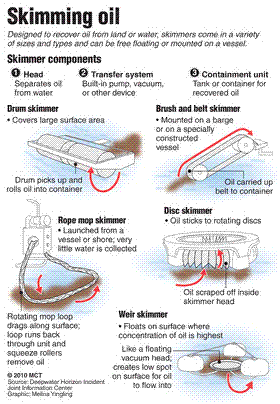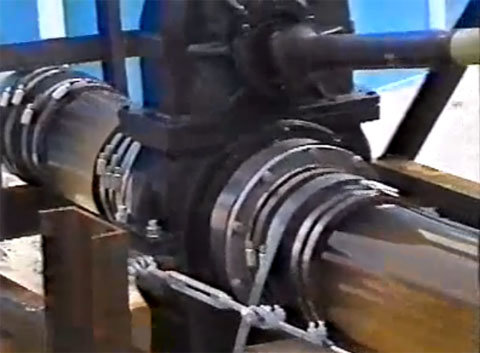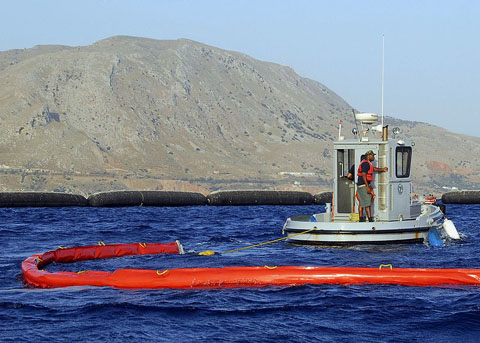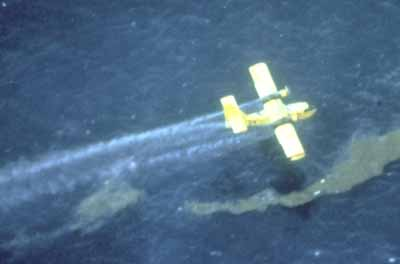Abstract
There have been a lot of reports covering issues related to oil spills in the world. The reports cover issues ranging from causes of oil spills to the effects of oil spills on the environment. This report is also covering some of the issues in a different perspective. The body of the report deals mainly with methods of controlling and cleaning up oil spills especially in the oceans.
Since the beginning of petroleum industry, and subsequent occurrence of oil accidents, several methods have been developed to aid in the clean up of the mess. Oil companies are faced with the challenge of cleaning up the mess in the recent past. This is because environmental groups, animal rights groups and human rights activists together with other agencies have emerged with policies which can be quite detrimental to the smooth running of the companies that violate those policies.
Although there are different methods of cleaning up oil spillage, advancement of these methods should be done in order to cope with the increasing challenges. A good example given in this report is the recent oil spill in the Gulf of Mexico.
The challenges faced by BP Oil Company attests to the fact that advanced technological input is needed in this area. The overwhelming task of solving the problem from its source proved to be a daunting task to the experts. Although it was a success, this incident left a negative mark on the environment that will not be forgotten for years to come.
At the end of this study, the causes and methods of cleaning up oil spills will be crystallized. The effectiveness of these methods will also be known and the need for better facilities is greatly emphasized.
Introduction
An oil spill is a situation that occurs when crude oil is accidentally poured out so that its effects are directly felt by the environment. Oil accidents have been occurring since the beginning of the petroleum industry since it is quite impossible to mine oil without spilling some.
The main causes of oil spills are accidents and operations at the port (Oracle, 2010). For instance collision is a familiar accident to mariners. Other accidents include explosions and groundings. Operations at the ports have also been causing small but several oil spills. Some of these operations include loading and discharging of oil.
Basically there are two kinds of oil spills. One kind is the one that occurs on land. Land oil spills usually occur in confined localities. Thus they are easily contained whenever they occur. Also, they do not cause much alarm since the situation is usually localized. In this situation, pollution is also localized hence clean up is easy and the effects are not adverse.
On the other hand, marine oil spills are quite familiar and thus infamous. Sine water moves with current, marine oil spills tend to spread over large areas thus causing far reaching environmental degradation. Oil spills in the oceans have been known to occur in different ways.
The main causes of oil spills in marine environment are tankers. Tankers are large water vessels used to transport enormous volumes of crude or refined oil. When an accident occurs involving a tanker, it will cause it to release its contents into the sea thus causing an oil spill.
Pipelines are also other source of oil spills in marine environment. When a pipeline is damaged crude or refined oil will be released into the sea causing similar damage to the environment. Thus the main sources which lead to the release of oil into the ocean are related to transport of oil. Offshore drilling does also cause oil spills when they explode or when there is an oil leakage. However, this is only but a small percentage of the total oil spills that occur in the world.
As we move away from the causes of oil spills to the methods of cleaning up, we find that in between these situations, there is the environmental aspect. Environmental degradation occurs when oil is accidentally poured into water or ground. Sea dwelling animals will be affected to a great deal if measures are not taken to cub the situation. Shellfish, seals, corals and many others will experience difficulties in either breathing or in absorption of nutrients.
Similarly plants and animals living at the shores will also experience a lot of problems in their livelihood. Turtles and birds in these areas are usually among the first animals to become victims of oil spills. In addition oil spills cause a lot of financial loss to the company in terms of wastage. For these and many other reasons, clean up activities are needed in order to prevent or tame the issue of environmental degradation and to recover the oil from the spill.
There is currently a number of methods oil companies use for clean up purposes. The methods range from natural to artificial techniques, and to more advance mechanized techniques. This report tries to dissect through the range of methods oil companies can use during clean up activities.
Causes of oil spills
Oil spills are caused by many sources. These causes are:
- Accidents, whereby collision, hull failures and fires caused in the refineries and oil rigs can cause oil to spill over to the surroundings (Graham, 2010). Grounding is also another accident which is commonly experienced in the oil industry. This type of accident causes the greatest number of loss of oil whereby several hundreds of accidents have been known to cause loss of several hundreds of tones of oil.
- Operations of the routines in the port and terminals whereby small but several oil spills can occur while loading or discharging. This has been known to be the most common cause of oil spills (Graham, 2010).
Factors affecting method of clean up of oil spills
Several factors affect the choice of a clean up method. These factors include:
- Density of the oil in relation to water so that if the density of oil is considerably high, it will sink into the water. This will prompt the use of a method which can be able to separate water and oil using the physical attribute of density (Oracle, 2007).
- Temperature of water; if the temperature of water is high or increases, oil will tend to evaporate. Natural methods may be employed here. Hence methods that can separate water from oil in this temperature have to be used.
- Capacity of the oil spill; if the volume of the oil spill is high, more advanced techniques should be employed so that clean up and the recovery of the spilled oil may be quickened (Oracle, 2007).
- How near the spill is to the coast; if the oil spill is near to the coast, or it is in an enclosed area, methods to be used should be aimed at preventing the oil from reaching the continental shores. This will help in prevention against continental environment degradation so as not to affect birds and other animals inhabiting the coast. The methods to be used in this situation should also be aimed at reducing the impact of the spill to corals and other shallow water dwelling organisms.
- Wave action of the water mass; whereby methods to be used should be able to withstand the challenge of physical mixing of sea water and oil. These should be methods which are used to separate the oil from the water after the two have mixed.
- The weather, strength and direction of wind and currents; methods to be used here should include those that can withstand specific weather conditions while not effecting performance of their chores.
Methods of clean up of oil spills may be natural or artificial. Artificial methods may be low or highly technical. Less technical methods include skimming, burning of the oil, or even physically using containers to scoop it or prevent it from spreading. Highly technical approaches include the use of dispersants and the use of organic agents to break the oil down. All these techniques must be carefully studied before they are finally recommended to any kind of spill.
Natural methods that use sunlight and wave action
Presence of oil in water can be broken down to physically disintegrate it and make it easier to evaporate in the presence of sunlight (Davidson, Lee & Cogswell). That is why some specialists usually ignore small oil spills that are susceptible to this natural method of clean up because their danger to the environment may be negligible.
Since oil is less dense than water, it will float especially in the more dense marine water. Light crude oil can also float in fresh water. However, the heavier crude petroleum can sink especially in fresh water. If the heavy oil sinks it mixes with water. This is because the oil gradually breaks down (Davidson, Lee & Cogswell). If there are sands and other particles in the water, the mixture of crude oil and water and these particles will form tar balls (Clark, 2010).
Tar balls are characterized by their small sizes, dark color and hard covering. But if they are to be broken, their inside is usually soft. They are often found separated from each other and scattered throughout the water. This is one of the reasons as to why tar balls are less risky to the environment than concentrated oil slicks.
Other natural ways can be artificially induced. The use of sorbents (absorbents) has been applied lately in the exercise of oil clean up. A sorbent is a material which attracts and causes a liquid to adhere to its fabric. For instance human hair can be used in the clean up of oil spills. Certain companies make mats from human hair that has been donated. The mats can then be spread over an oil spill to separate the oil from water. Good sorbents for this particular purpose are usually those sorbents that can attract oil and resist water.
Use of dispersants
Dispersants are mostly used in areas around the tropics. A dispersant is a chemical which when applied to a substance will physically break it down into smaller particles (Clark, 2010). Hence dispersants are used as catalysts in the physical breakdown of oil spills into smaller volumes so that the oil may be easily absorbed in the water (Hazen, 2010).
The process uses the basic principle of physics that it is easier to dissolve small substrate particles into a solvent than larger particles (see appendix, fig 4). This principle holds because the smaller particles have increased surface area.
This is because oil does not break down as quickly as such. Chemical dispersants can be deployed underwater near the source of the leaks in offshore oil rigs. This helps in preventing the crude oil from rising to the surface.
Currently this method is used but it is still undergoing extensive studies in relation to its impacts on the deepwater ecology (Kaufman, 2010). However this method is quite disadvantageous since the dispersants used are harmful to marine and aquatic organisms. In 2007, there was a research on the use of dispersants as methods of oil clean up.
This study was actually done in Israel. It was revealed that the mixture of crude oil and dispersants is more dangerous to marine and aquatic organisms (Hazen, 2010). The actual studies showed that coral reefs would be better of in absorbing raw crude oil than this mixture. The other effect of dispersants is the likelihood of contamination of sea foods. However this issue is still being studied.
Biological agents
Biological agents are used to clean up crude oil that has already found its way to the shores. Oil leaks reach the shore when a tanker sinks, or when an oil refinery which is situated at the coast begins to leak. There are also some situations when oil spill tends to move towards the coastal regions. This prompts the use of biological agents. Biological agents are the microorganisms that are used to break down substances into organic or natural substances (Hazen, 2010).
They are involved in either aerobic or anaerobic respiration to produce fatty acids and carbon dioxide. This method is used whereby when an oil spill occurs near a shoreline, fertilizers are applied on the oil. The purpose of the fertilizer is to speed up growth of microorganisms so as to aerobically or anaerobically manufacture organic components by the breakdown of this oil.
Currently there are companies which sell microbes that eat oil. This process is called bioremediation (Miami herald, 2010). An example of some of the oil-eating microorganisms is Alkanivorax borkumensis. These are described as some of the smallest living organisms which can have a powerful impact on the prevention of oil slicks. These microbes occur in water naturally whereby they eat up oil in water to produce carbon dioxide as a bi product (Miami herald, 2010).
Use of oil booms
This is the most basic method to respond to an oil spill. A boom is a brightly colored long fabric (see appendix, fig. 3). It has a filler attached on its length and. It also has a heavy chain or ballast. The heave chain or ballast causes it to sink while the filler causes it to float on water. Its bright color enables the crew to recognize a break along its length and also helps in the recovery process.
The surface of the boom is made so that splash-over may be reduced whereas the bottom part is made in a way that will prevent the captured oil from leaking back into the water (Graham, 2010). The method may however become difficult to use alone especially when the oil spill has been dispersed over a large area so that it becomes difficult for circular containment.
The use of skimmers
This technique is used to remove oil spills especially in slow moving waters, sheltered waters or at the shores. The oil must be at the surface. The main principle of operation of this method is the use of adhesive property of oil (see appendix, fig. 1). In physics it is a well known fact that oil will stick to any surface passing though it. These machines employ gravity, suction and rotation as the main principle of mechanical operation for motion to be achieved (Graham, 2010). The working principles of the machines for the purposes are:
- It renders a continuous surface so that the spilled oil can cling to.
- The surface is then cleaned.
- And the cycle is repeated.
Skimmers come in various types which include:
- Belt skimmers.
- Brush skimmers.
- Mop skimmers and
- Floating solution skimmers.
The use of separators
Oil may be harbored in water as free oil, emulsified or even as dissolved oil. Free oil is the oil which exists in the size of 20 microns. Oil which is less than 20 microns is called emulsified oil while dissolved oil has completely dissolved in water. The oil globules are moved to the surface of the separator vertically by virtue of their density compared to the density of water (see appendix fig. 2). The separators use principles of centripetal and centrifugal forces to separate oil from the water (Graham, 2010).
The mixture of oil and water is spun so that they may separate since they have different densities. When the fluid in question enters the separator, a strong current is created. This current causes outflow of higher density water while the lower density oil sucks in the separator. At the end of this pipe, the water and the oil are collected separately (Graham, 2010).
It is worth noting that oil spill clean up is never an easy task. Due to this reason, a combination of two or more of the methods discussed above becomes necessary. For instance when there is a large oil slick which threatens the coast, the combined use of booms and dispersants is employed to quicken the clean up. Oil leaks which threaten to infiltrate the coast or those which occur at the coast are usually trickier to deal with.
These situations therefore, will require delicate methods to do the clean up (Clark, 2010). Another way which can help during the clean up process is drilling a well near the oil leak. This helps relieve the pressure of the gushing oil which in turn reduces the volume of the oil spill. The methods has been used lately by the BP company in the recent clean up of the gulf oil leak in the Mexican coast (BBC, 2010).
Recommendations and conclusions
As it has been seen in the study, recommendations on the advancement of technology to solve this issue have to be considered. Better tankers need to be designed and built in order to prevent oil spills. Better drilling machines which are more resistant to breakage should be invented. High quality pipes that are more resistant to corrosion should be manufactured to prevent oil leakages. Minimization of oil spills during discharge and loading should be enhanced. High tech facilities should be employed in clean ups should the incidences occur.
In conclusion, this project has highlighted the main types of oil spills and how the oceanic oil spills can be cleaned up. These main types are oceanic oil spills and land oil spills. From the report it is evident that oil spills on land are more manageable than oil spills in the oceanic fronts. Oceanic oil spills cause a great environmental hazard hence cleans up exercise needs to be followed immediately in occurs.
The methods of cleaning up oil spills in the ocean are grouped into natural methods and artificial methods. Natural methods involve the use of sunlight, wind waves and ocean currents to oblige dissolution of the oil. Artificial methods include the use of machinery such as booms, separators, skimmers and dispersants for oil clean ups. The input of organic agent into this exercise is also grouped under this category (Hazen, 2010).
As a summary to the aims of this report, the causes of oil spills, clean up methods and analysis of each method discussed in this report is aimed at creating awareness. This awareness will impart on the concerned parties to enhance their goals such that every individual concerned or affected will not be victimized so as not to compromise their rights.
APPENDIX: Figures of instrumentation methods used in cleaning up oil spills




Reference List
Clark, J. (2010). How Stuff Works, How do you clean up an oil spill? Web.
Davidson, W, Lee, K & Cogswell, A. (2006), Oil spill response: A global perspective. Published by Springer, pp 206-208.
Graham, P. (2010). Deep Sea Oil Spill Cleanup Techniques: Applicability, Trade-offs and Advantages. Web.
Hazen (2010), Interview with Science News, Caution Required for Gulf Oil Spill Clean-Up, Bioremediation Expert Says, 1995-2010.
Kaufman, L (2010). The New York Times. New Technique Holds Hope for Oil Spill Cleanup. Web.
Miami herald (2010). Gulf Oil Spill, oil-eating microbes a possible solution. Web.
Oracle, (2007). Think quest, education foundation. Web.
Russell, L (2010). Alternative Cleanup Methods for Cleaning Oil Spills in Water. Web.